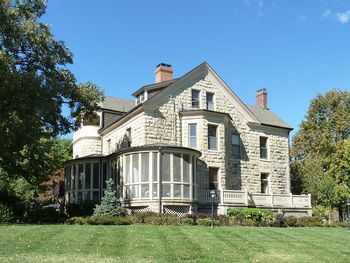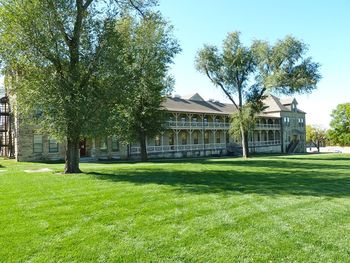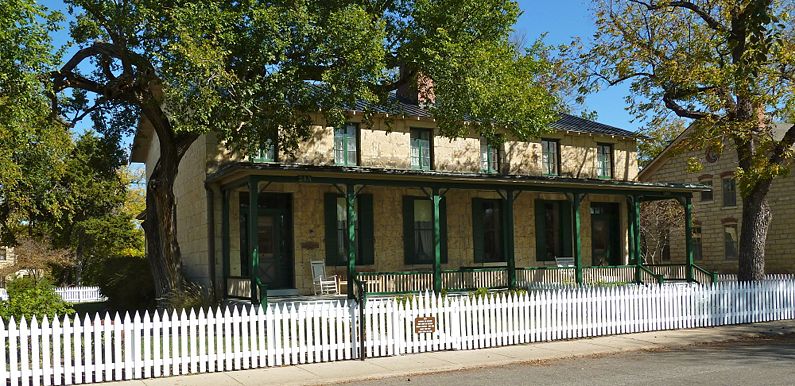Fort Riley (2)
|
Fort Riley (2) (1853-Present) - First established in 1853 as Camp Center. Renamed Fort Riley 27 Jun 1853 after Major General Bennett C. Riley, who led the first military escort along the Santa Fe Trail in 1828 and who died 6 Jun 1853. Active military installation. Included Camp Funston (1), Camp Whiteside and Camp Forsyth.
History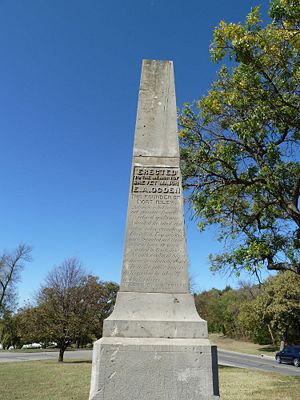 Established 17 May 1853 near the strategic junction of the Republican and Smokey Hill Rivers near present-day Junction City, Kansas. The initial post, known as Camp Center, was established by Captain Charles S. Lovell and companies B, F, H, 6th U.S. Infantry. Permanent post construction began in June 1855 with hundreds of civilian workers and very soon after a cholera epidemic broke out. Over 75 workers died and some 150 troops mutinied and deserted. Among the dead was the post commander, Bvt. Major Edmund A. Ogden (Cullum 649). The original post was an open plan western fort with a central parade lined with three sets of officer quarters on the south and north ends. Three sets of enlisted barracks lined the east and west sides. Five large stables were located to the southwest of the parade and the hospital was located behind the enlisted barracks on the east side. The original limestone hospital now serves as the Cavalry Museum. Most of the original post stone buildings were built with limestone blocks cut in the "pasture cut" style, with smooth sides. This style of construction can be seen in the Custer House and in the old Hospital, now the Cavalry Museum.
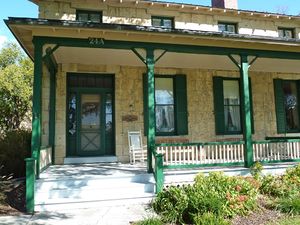 The 7th U.S. Cavalry was first organized at Fort Riley in 1866 under the command of Bvt. Major General George A. Custer (Regular Ltc.) (Cullum 1966) who made them into one of the best cavalry units in the west. In 1867 Custer left his command and returned to Fort Riley when a second cholera epidemic threatened his wife. He was court-martialed and relieved of command for a year. Major General Philip H. Sheridan (Cullum 1612) restored Custer to duty before his suspension was up. The officer's duplex quarters 24A, once thought to be the residence of General Custer, is preserved and outfitted with period furnishings. The actual residence is now thought to be quarters 21A which has been extensively renovated and is still in use as officers quarters.
U.S. Civil WarDuring the U.S. Civil War in 1862 Fort Riley housed a small number of Confederate prisoners of war numbering about 17 maximum at any one time. Of these prisoners, there were 8 deaths. Post U.S. Civil WarIn the mid-1880s Fort Riley became the home for two schools that cause a great expansion of the post. The Cavalry School and the Light Artillery School caused the development of two distinct parts of the post, each with its own parade ground, officer's row and enlisted barracks. The Cavalry School was built around the old post area, the old parade ground became the Cavalry Parade and the officer's row that now lines Forsyth Avenue was built between 1887 and 1903 for the Cavalry officers. The Light Artillery school area was the horseshoe-shaped Schofield Circle with officer's quarters lining a parade ground and enlisted barracks on the opposite side. Each of the two areas had almost identical quarters for the respective commanders. The Light Artillery School area was also built between 1887 and 1903. The stone construction done during this period was done in the "hammered stone" style with each stone having a rough exposed surface. The majority of buildings on the historic main post are done in this style.
World War ISee Camp Funston (1). Fort Riley greatly expanded during World War I to accommodate the thousands of recruits who trained there. The eastern part of the reservation became Camp Funston (1) in 1917, built in 20 days, at a cost of $10 million dollars the camp eventually covered some 2,000 acres and trained some 50, 000 men during World War I. Like most of the temporary World War I construction, Camp Funston was torn down in the 1920s and the lumber sold at auction. Camp Funston became a maneuver area. World War IIIn the lead up to World War II, Camp Funston (1) was rebuilt again with temporary buildings and used for training. Camp Whiteside, established in 1924 as a National Guard Camp on the Fort Riley reservation, became a hospital complex. Camp Forsyth was built in 1940 and became a cavalry replacement center that trained 150,000 horses and cavalrymen during the war.
Current Status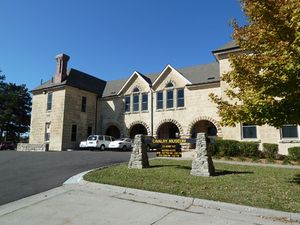 An active military installation, now the home of the 1st U.S. Infantry Division. The military reservation encompasses 100,671 acres in two counties and houses over 10,000 soldiers. Over 3000 sets of family quarters are provided for married members and their families. Historic quarters are located on the main post around the Cavalry Parade and the Artillery Parade. Historic sights include the Custer House, officer's row and two parade grounds surrounded by historic quarters and barracks. Two museums are open to visitors, the U.S. Cavalry Museum and the Fort Riley 1st Infantry Division Museum. Monuments and memorials are scattered throughout the post and include the Wounded Knee Monument, the Great War Memorial, the "Old Trooper Monument" and the grave of "Chief", the last Cavalry Mount on the rolls of the U.S. Army. Chief was buried upright in front of the Old Trooper Monument at the Cavalry Parade Ground. Visitor access is permitted for U.S. Nationals by an application at the visitor center. Walking and driving tour instructions available at the Cavalry Museum. Custer House tours are available during the summer season.
See Also: Sources:
Links:
Visited: 15 Oct 2011 Picture Gallery
| |||||||||||||||||||||||||||||||||||||||||||||||||||||||||||||||||||||||||||||||||||||||||||||||||||||||||||||||||||||||||||||||||||||
